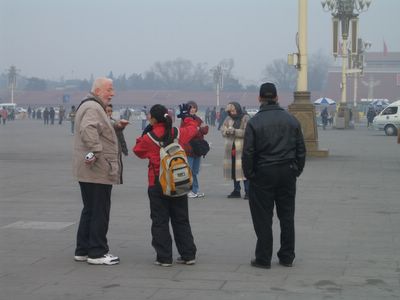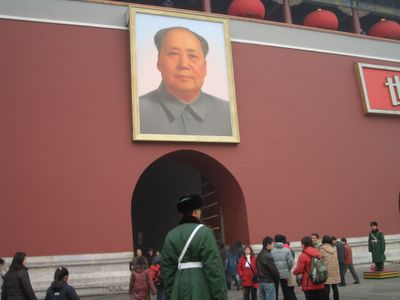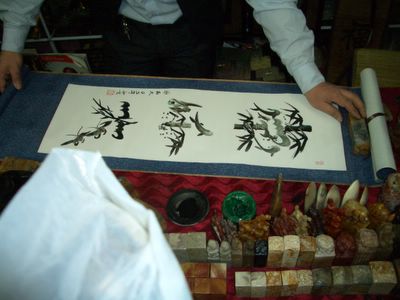In China, Day 6: Tian'anmen and More Shopping
This is our last day of sight seeing by ourselves. Tommorrow, the 15th, we go on the group tour to the Great Wall and the Forbidden City.
Our plan is to visit Tian'anmen Square, have lunch, and then go shopping at the fabled wholesale market that we couldn't go to before because it was closed for the holiday. We all still have lots of things to buy, mostly gifts for people on our gift lists.
We are going with our emergency backup guide Snow because Amy is occupied with meeting the last of the Great Wall families who are arriving today. The air quality today is very poor--a white haze that reduces visibility to about half a mile. We can tell that the sky is otherwise clear, but the haze is very thick. It gives the city a certain surreal, Blade Runner quality, especially as we drive past the endless ranks of high-rise appartment buildings that seem to go on forever.
After our usual 40-minute drive into the city we arrive at Tian'anmen Square. Like the Great Wall or the Grand Canyon, it is impossible to understand the sheer size and scale of the place from pictures. It is huge and is surrounded by looming government buildings in the universal style of looming government buildings. In the center is Mao's Tomb, which any place else would be a massive buildng, but here it's just the center piece of the much larger square.
 We entered the square from the west side. From here you look north toward the Forbidden City and the huge picture of Chairman Mao that hangs above the gate into the Forbidden City. The air quality was such that from this position it was difficult to see the picture through the haze. The square was busy with people, mostly families, here for sight seeing and to visit Mao's Tomb. It is still a school holiday and it was also Valentine's Day, which is pretty big here in China (in fact there was a story in the paper this morning that Valentine's Day this year had been somewhat eclipsed by the New Year holiday). There were a number of people trying to fly bird kites, which was a challenge because there was essentially no wind. These were mostly older guys with big reels of string that would use the reels to pull the kites up into the air. The lack of wind and the nature of the kites caused them to fly very flat and sort of wheel around, which made it look from a distance like there were vultures or big sea birds wheeling low over the square.
We entered the square from the west side. From here you look north toward the Forbidden City and the huge picture of Chairman Mao that hangs above the gate into the Forbidden City. The air quality was such that from this position it was difficult to see the picture through the haze. The square was busy with people, mostly families, here for sight seeing and to visit Mao's Tomb. It is still a school holiday and it was also Valentine's Day, which is pretty big here in China (in fact there was a story in the paper this morning that Valentine's Day this year had been somewhat eclipsed by the New Year holiday). There were a number of people trying to fly bird kites, which was a challenge because there was essentially no wind. These were mostly older guys with big reels of string that would use the reels to pull the kites up into the air. The lack of wind and the nature of the kites caused them to fly very flat and sort of wheel around, which made it look from a distance like there were vultures or big sea birds wheeling low over the square. We wandered about just taking in the ambiance of the place, Bill videoing here and there. We stopped to study the majestic, inspiring Socialist statues in front of Mao's Tomb. We were then faced with the question of whether or not to see Mao. On the one hand it is a major attraction and a unique sight, the corporeal remains of one of the great figures of 20th Century history. On the other hand, it's standing in a long line in order to spend a few seconds looking at what may or may not be the body of an old dead dude. But the line wasn't too long and Mr. Liu our driver seemed to really want us to do it and we would probably regret not having done it, so we decided to go. Then we were faced with the logistical problem that no bags or cameras are allowed in, so we decided to go in shifts, which we did.
We wandered about just taking in the ambiance of the place, Bill videoing here and there. We stopped to study the majestic, inspiring Socialist statues in front of Mao's Tomb. We were then faced with the question of whether or not to see Mao. On the one hand it is a major attraction and a unique sight, the corporeal remains of one of the great figures of 20th Century history. On the other hand, it's standing in a long line in order to spend a few seconds looking at what may or may not be the body of an old dead dude. But the line wasn't too long and Mr. Liu our driver seemed to really want us to do it and we would probably regret not having done it, so we decided to go. Then we were faced with the logistical problem that no bags or cameras are allowed in, so we decided to go in shifts, which we did.It was an interesting experience. You stand in this line that moves pretty quickly but in a very calm and stately way as everyone is very solemn. It's clear that the people are taking this very seriously, so we did our best to be solemn and reverential as well. One interesting thing is that about half way along the line into the tomb you pass a kiosk selling small bouquets of long-stemmed flowers. These are for placing in front of the statue of Mao that sits just inside the entrance to the tomb as a sort of offering.
Once inside the tomb the line splits to the left and the right and you then file past the body, which is in this glass case. As you might imagine it's a little creepy but also very solemn--after all it is the body of a revered leader. Once past the body you pop out into the afterchamber, where you can buy souveniers and then you are back outside and heading out of the tomb area, past more tables of vendors selling trinkets, cigarettes, and what not.
Snow said that she has visited Mao's tomb about 50 times.
 Once we had all been through we wandered back in the direction of the Forbidden City, went under the street using the pedestrian underpass, went up under the picture of Mao for a quick photo opportunity, and then back to the van to go to lunch.
Once we had all been through we wandered back in the direction of the Forbidden City, went under the street using the pedestrian underpass, went up under the picture of Mao for a quick photo opportunity, and then back to the van to go to lunch.We had our lunch at a very nice Sichuan place in this fancy department store. Once again we had a variety of really excellent food, most of which was different from anything we've had so far, including some very tasty greens with thai peppers and this fish cooked with red chili poweder and cumin that was just wonderful.
Finally, on to the wholesale market. By now we are seasoned China hands when it comes to bargaining so we felt well prepared. The only problem I realized is that while we have the bargaining process down, we don't necessarily know what a good price would be for the things we were buying. I also found that after a couple of hours I was losing the energy to really bargain hard, so I ended up overpaying a little bit for some stuff. But we certainly weren't paying the huge foreigner markup that was being asked. I was also pleased that my focus on learning my numbers in Chinese was paying off, allowing me to conduct transactions almost entirely in Chinese and without resort to the calculator in many cases. For me learning the numbers in a new language is often the hardest thing to do initially, especially with enough fluency to be able to talk about prices. But Chinese numbers are particularly easy to learn, as all you have to learn is the words for the numbers zero to 10, the word for "hundred" and you're done--all numbers are simple and consistent combinations of these words (at least for values less than 999). The key is "shi", the word for "ten". For the numbers 11 to 19 you simply say "ten x" where "x" is 1 to 9: shi yi, shi er, shi san, etc. To say numbers between 20 and 99 you say "x shi y" where "x" is the tens place and "y" is the ones: "er shi san" is 23, "wu shi si" is 54, etc. For numbers between 100 and 999, you give the hundreds place followed by the word for "hundred", bai: "yi bai er shi" is 120, "er bai" is 200, "san bai wu shi san" is 353. Couldn't be easier. For the curious, the numbers are 1: yi (ee), 2: er (are), 3: san (like the 'san' in "sauna"), 4: si ("su", more or less), 5: wu (oo-oh) (3rd tone), 6: liu (lee-oo), 7: qi (chee), 8: ba ("ba" as in ba ba black sheep), 9: jiu (jee-oh), 10: shi ("shuh" as in "shush"). Zero is "ling" (rhymes with "ring"), 100 is "bai" (buy).
The biggest problem I have is distinguishing the word for four (si) from the word for ten (shi), which are subtly different to English speaking ears. However context and hand gestures are usually sufficient to clear things up. And if that doesn't work there is always the calculator.
In fact my biggest number confusion of the day came when I was buying an ice cream bar and the woman was giving me the price in English (seven) but I was trying to hear it as Chinese and it just wasn't making any sense.
 Needless to say we bought lots of stuff as a group, although we were all mindful of our luggage limits so we didn't go nuts. Judy found a caligrapher to paint scrolls with the Chinese names for Briana, Kelly, and Yu-da. She got invaluable help from Snow and Mr. Liu, who went to great lengths to make sure that all the characters were the correct characters (there was some argument about which character to use for "Nan", Yu-da's orphanage family name, since we were working from memory). Eventually the scrolls were produced and they look really nice. I'm sure they will be treasured keepsakes.
Needless to say we bought lots of stuff as a group, although we were all mindful of our luggage limits so we didn't go nuts. Judy found a caligrapher to paint scrolls with the Chinese names for Briana, Kelly, and Yu-da. She got invaluable help from Snow and Mr. Liu, who went to great lengths to make sure that all the characters were the correct characters (there was some argument about which character to use for "Nan", Yu-da's orphanage family name, since we were working from memory). Eventually the scrolls were produced and they look really nice. I'm sure they will be treasured keepsakes.Finally we had shopped until we could shop no more, made our way back to the van and thus back to the hotel, where we hung out in the bar with Amy, who was off duty, and gave her a slide show of family photos and the pictures we had taken so far.
Tommorrow: big group touring....









0 Comments:
Post a Comment
<< Home